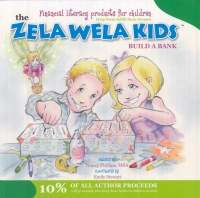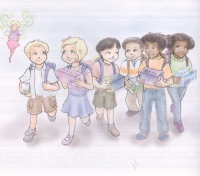| ________________
CM . . .
. Volume XVII Number 13. . . .November 26, 2010 
 |
The Zela Wela Kids Build a Bank.
Nancy Phillips. Illustrated by Emily Stewart.
Bloomington, IN: AuthorHouse (www.authorhouse.com), 2010.
32 pp., pbk., $13.75.
ISBN 978-1-4490-7413-5.
Kindergarten-grade 2 / Ages 5-7.
Review by Dave Jenkinson.
* /4 |
| |
|

excerpt:
“Okay, class. On the second box please print the words “Invest.” The purpose of putting money in this box is to make your money grow and grow and grow, the same way a little pumpkin seed grows into a big round pumpkin.”
“The idea of investing money is to use the money you have to make more money, to make it grow. You don’t have to start off with a lot of money - quite often just having a great idea can get you on your way. But you need to do it and keep doing it. That’s the key. You will learn more about doing this as you get older. Make sure you ask people lots of questions along the way.”
In the same way that we, as parents, may try to mask a child’s bad tasting medicine by mixing it in with something sweet, some authors think that by their using the format of a children’s picture book, they can then deliver a didactic message to youngsters. Rarely is either scenario truly successful, and The Zela Wela Kids Build a Bank is definitely not one of the exceptions.
 Certainly, Nancy Phillips, who holds a B. Sc (Hons.) from the University of Guelph and an Executive MBA from Queens and has some twenty years of sales experience, is well qualified to write about money management, but, as shown in the above excerpt, her ability to do so in language that will connect with The Zela Wela Kids Build a Bank’s young audience is lacking. Certainly, Nancy Phillips, who holds a B. Sc (Hons.) from the University of Guelph and an Executive MBA from Queens and has some twenty years of sales experience, is well qualified to write about money management, but, as shown in the above excerpt, her ability to do so in language that will connect with The Zela Wela Kids Build a Bank’s young audience is lacking.
Phillips’ narrative vehicles for her story are the fraternal twins, Jack and Emma, who leave school on a Friday afternoon and excitedly tell their mother that next week their teacher, Mrs. Davies, is going to have them build savings banks from individual serving sized cereal boxes, and that they each need four such boxes which they are to glue together over the weekend. Monday of the following week sees the twins and their classmates, under Mrs. Davies’ direction, labelling the four parts of their banks with the terms “Give”, “Invest”, “Save” and “Spend.” Using a dollar as the amount to be allocated among the four portions of the bank, Mrs. Davies suggests that 10 cents be put in “Give”, 15 cents in “Invest”, 25 cents in “Save” and the remaining 50 cents in “Spend.” Mrs. Davies also explains that these “percentages” can be changed as the children consult with their parents.
Parents, especially those who do not already budget, will likely get more out of the contents The Zela Wela Kids Build a Bank than will their young children. The Zela Wela Kids Build a Bank is simply an information-giving book that is covered by the thinnest veneer of a storyline, one that is not particularly engaging. Youngsters might initially be attracted by the book’s title which suggests that they will learn how to construct a bank, but neither the text nor the accompanying illustrations provide enough clear instructions to guide them through the process. Additionally, given the book’s title, children will likely wonder who the Zela Wela kids are and will probably assume that they are Jack and Emma, but nowhere in the book is that assumption confirmed or contradicted.
Stewart’s illustrations have a cookie-cutter feel to them. Oddly, in some of the illustrations, she has a Tinker Bell-like creature flitting about, and its identity and purpose are never made clear.
Especially in our seemingly debit and credit card driven world, one cannot argue with the sound financial advice that Phillips seeks to provide in The Zela Wela Kids Build a Bank. Unfortunately, while her intent in having this “lesson” learned early in life was most laudable, the vehicle she used to deliver her message was very poorly executed.
Not recommended.
Dave Jenkinson, who is CM’s editor, lives and budgets in Winnipeg, MB.
 To comment
on this title or this review, send mail to cm@umanitoba.ca.
To comment
on this title or this review, send mail to cm@umanitoba.ca.
Copyright © the Manitoba Library Association. Reproduction for personal
use is permitted only if this copyright notice is maintained. Any
other reproduction is prohibited without permission.
NEXT REVIEW |
TABLE OF CONTENTS FOR THIS ISSUE
- November 26, 2010.
AUTHORS |
TITLES |
MEDIA REVIEWS |
PROFILES |
BACK ISSUES |
SEARCH |
CMARCHIVE |
HOME |
|

 Certainly, Nancy Phillips, who holds a B. Sc (Hons.) from the University of Guelph and an Executive MBA from Queens and has some twenty years of sales experience, is well qualified to write about money management, but, as shown in the above excerpt, her ability to do so in language that will connect with The Zela Wela Kids Build a Bank’s young audience is lacking.
Certainly, Nancy Phillips, who holds a B. Sc (Hons.) from the University of Guelph and an Executive MBA from Queens and has some twenty years of sales experience, is well qualified to write about money management, but, as shown in the above excerpt, her ability to do so in language that will connect with The Zela Wela Kids Build a Bank’s young audience is lacking.